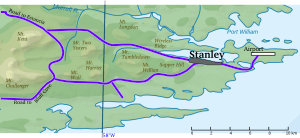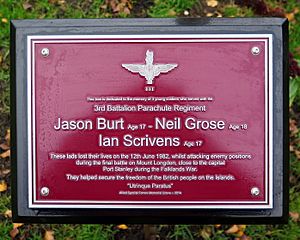Battle of Mount Longdon facts for kids
Quick facts for kids Battle of Mount Longdon |
|||||||
|---|---|---|---|---|---|---|---|
| Part of Falklands War | |||||||
 Mountains around Mount Longdon |
|||||||
|
|||||||
| Belligerents | |||||||
| Commanders and leaders | |||||||
| Units involved | |||||||
|
10th Mechanized Infantry Brigade
|
||||||
| Strength | |||||||
| 450 6 light guns 1 frigate |
278 | ||||||
| Casualties and losses | |||||||
| 23 killed 54-60 wounded | 31 killed 120 wounded 50 captured |
||||||
The Battle of Mount Longdon was a fierce fight during the Falklands War. It happened on June 11–12, 1982. British soldiers from the 3rd Battalion, Parachute Regiment fought against Argentine soldiers from the 7th Infantry Regiment. This battle was one of three major fights that night. The others were the Battle of Mount Harriet and the Battle of Two Sisters. After tough fighting, the British took control of Mount Longdon. This was a very important spot near Port Stanley, the capital. The battle ended with a British victory.
Contents
Background to the Battle
British Forces Prepare
The main British force was the Third Battalion, the Parachute Regiment (3 PARA). Their leader was Lieutenant Colonel Hew Pike. They had strong support from six 105mm L118 light guns. These guns belonged to the 29 Commando Regiment, Royal Artillery. A Type 21 frigate called HMS Avenger also helped with its 4.5-inch gun. Another British unit, the Second Battalion, the Parachute Regiment (2 PARA), was kept ready as a backup.
Argentine Forces Defend
The Argentine forces on Mount Longdon were mainly from B Company, 7th Infantry Regiment (RI 7). They were part of the 10th Mechanized Infantry Brigade. Their local commander was Major Carlos Carrizo Salvadores. He was 34 years old and second-in-command of RI 7. The 7th Infantry Regiment also had help from two Marine platoons. They defended Mount Longdon, Wireless Ridge, Port Stanley, and Cortley Ridge.
The Argentine soldiers were mostly reservists. They had a year of military training. They had practiced large-scale training exercises. These exercises included other army units. Some soldiers had even completed special commando training. They were ready to hold their ground. Their weapons included FN FAL rifles, FAP light machine guns, and PAMS sub-machine guns. These were fully automatic. They also had FN MAG machine guns, which were similar to the British ones.
One soldier, Private Jorge Altieri, described his training. He learned to use different rifles and machine guns. He also learned how to use a bazooka. They practiced making booby-traps and navigating at night. They did helicopter drills and practiced night attacks.
Argentine engineers had placed about 1,500 anti-personnel mines around Mount Longdon. These were on the western and northern slopes.
The Battle Begins
British Advance on Mount Longdon
The British 3 PARA and Royal Engineers began a tough march. They moved across hills north of Mount Simon. Their goal was to capture the high ground near Estancia. The weather was terrible. Soldiers marched through steep, wet hills. The wind was freezing, and it rained sideways.
Captain Matthew Selfridge of 3 PARA and Captain Robbie Burns from the Royal Engineers set up a base. It was near Murrell Bridge, west of Mount Longdon. They sent out patrols to check on Argentine positions. One Royal Engineer was seriously wounded during a patrol.
Terry Peck, a local islander, also helped with scouting. He pretended to be lost on his motorbike. He talked to Argentine soldiers guarding supplies. Later, he accidentally fired at a British patrol. Luckily, no one was hurt.
British patrols also tried to capture an Argentine soldier. They were supported by artillery fire. Argentine commanders quickly responded with machine guns and mortars. No Argentines were hurt in this incident.
Argentine commando units also patrolled the area. On June 7, a combined Argentine patrol approached Murrell Bridge. A firefight started in the dark. The British soldiers had to pull back quickly. They left some equipment behind. This meant their radio network might have been discovered. After this, British patrols stayed closer to their own lines.
Despite these patrols, British commanders thought the Argentine soldiers would not fight hard. They hoped to surprise them. The British planned to get very close before attacking. The main targets were called 'Fly Half', 'Full Back', and 'Wing Forward'. These are names from Rugby football.
Assault on Mount Longdon
As night fell, 3 PARA moved into position. They began their four-hour advance. As B Company got close, a British soldier stepped on a mine. This alerted the Argentine soldiers. They came out of their tents and started firing.
Lieutenant Jonathan Shaw's No. 6 Platoon captured the top of 'Fly Half' easily. But they had missed some Argentine troops. These soldiers then attacked the platoon from behind. This caused some British casualties. For three hours, there was close-quarters fighting. The British eventually pushed the Argentines out.
Small groups of soldiers fought bravely on both sides. British Privates Ben Gough and Dominic Gray crawled to an Argentine bunker. They threw grenades inside, then jumped in. They fought the Marines with bayonets. Private Gray killed a Marine. Both were later recognized for their bravery.
Marine Corporal Carlos Rafael Colemil was a sniper. He shot a British soldier who was giving orders. He also hit two other British soldiers. He said many fell screaming. But then, the enemy knew where he was. He was wounded soon after.
According to Private Victor José Bruno, Argentine Lieutenant Baldini was killed. He was trying to fix a jammed machine gun. Baldini's weapon and boots were taken by British soldiers.
Argentine Reinforcements Arrive
Argentine reinforcements arrived to help their soldiers. These were engineers with night-vision scopes. These scopes were very effective against the British.
The battle was tough for Major Mike Argue, the British commander. Argentine resistance was strong. In the middle of the mountain, Marine soldiers Jorge Maciel and Claudio Scaglione had a heavy machine gun. Marines Luis Fernández and Sergio Giuseppetti had rifles with night scopes.
Sergeant Ian McKay of the British forces saw that the Marine position was causing many problems. He decided to attack it alone. He charged forward, throwing grenades. He was killed in the attack. He was later awarded the Victoria Cross for his extreme bravery. Other soldiers tried to help but were also wounded or killed.
Major Carrizo-Salvadores, the Argentine commander, asked for more soldiers. A reinforced platoon arrived and launched a counterattack. The fighting was fierce and lasted for two more hours. The British slowly pulled back.
Argentine Counterattack
Major Carrizo-Salvadores moved the reinforced Argentine platoon forward. Part of this platoon moved towards the British aid post. Colour Sergeant Brian Faulkner saw that more than 20 wounded British soldiers were in danger. He quickly gathered any fit soldiers to defend the position. They opened fire on the approaching Argentines.
Major Argue's company stopped firing and focused on pulling back. They had suffered many casualties. Lieutenant Colonel Hew Pike arrived and was told about the difficult situation. The wounded were taken to safety. But the dead soldiers had to be left behind for a time.
Brigadier Julian Thompson, the British commander, said he almost pulled his soldiers out. He was surprised that the young Argentine soldiers were causing so many casualties.
The Argentine platoon that counterattacked was exhausted. Six were killed and twenty-one were wounded. One Argentine soldier, Private Leonardo Rondi, took a maroon beret and rifle from a dead British soldier. He later gave them to his commanders as trophies. Rondi was also recognized for his bravery.
British Resume the Attack
After the tough fighting, Major Argue pulled back some platoons. British artillery then fired at the mountain. The British then attacked the area from the left side. The remaining British platoons, led by Lieutenant Mark Cox, advanced. They faced more Argentine fire and took more casualties.
Private Grey was shot in the head but kept fighting. He refused to be evacuated until his unit was secure. Private Kevin Connery killed three wounded Argentines in this action. The British could not move forward without losing too many soldiers. So, they pulled back again.
Major David Collett's A Company was then ordered to attack. They would assault the eastern part of 'Full Back'. This was a very strong defensive position. They had covering fire from Support Company.
Lieutenant David Wright and Second Lieutenant Ian Moore led their platoons. They attacked the position, clearing it with rifles, grenades, and bayonets. As A Company cleared the last positions, Corporal McLaughlin was hit by a recoilless rifle round. He was then killed by a mortar round as he went to the aid post.
The Argentines fought hard to defend 'Full Back'. Corporal Manuel Medina, though wounded, took over a recoilless rifle. He fired at the British, killing three soldiers and wounding three others. Major Carrizo-Salvadores left his command bunker when a missile hit nearby. In the bunker, Major Collett found cigarettes, which he shared with his soldiers.
The British soldiers heard Argentines swearing in English. They also found dead Argentine Marines in camouflage. This made them think they were fighting American mercenaries at first.
Aftermath of the Battle

The battle lasted twelve hours. Both sides suffered many losses. The British 3 PARA lost seventeen soldiers. One Royal Engineer also died. Two of the British soldiers were only seventeen years old. Another was killed on his eighteenth birthday. Forty British paratroopers were wounded.
After the battle, four more British soldiers were killed by shelling. Seven more were wounded. Another eight British soldiers had been wounded earlier by friendly fire. One Royal Marine was also wounded while helping injured soldiers. The Argentines lost 31 soldiers, had 120 wounded, and 50 were taken prisoner.
Lance-Corporal Vincent Bramley saw the terrible results of the night fighting. He found the bodies of five British paratroopers. He described the sadness and anger he felt. The Company-Sergeant-Major looked very tired from seeing so many of his men hurt or killed.
Awards for Bravery
The 3rd Battalion of the Parachute Regiment received many awards for their actions in this battle:
- One Victoria Cross (Sergeant Ian McKay)
- One Distinguished Service Order (Lieutenant-Colonel Hew Pike)
- Two Military Crosses (Majors Mike Argue and David Collett)
- Two Distinguished Conduct Medals (Colour Sergeant Brian Faulkner and Sergeant John Pettinger)
- Three Military Medals (Sergeant Des Fuller, Corporal Ian Bailey, and Private Richard Absolon)
- Many soldiers were also Mentioned in dispatches.
Images for kids



